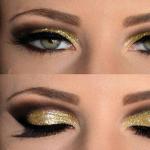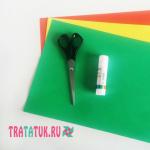Yarn for knitting rugs on fillet mesh. Homemade floor products using simple patterns: we make a rug on a mesh of threads with our own hands
Crochet a rug for any interior you can use this simple description, the main thing is to choose yarn in colors that match the decor of the room, and the geometric pattern of the knitted rug is universal. Description of knitting a rug on the grid accessible even to beginner needlewomen, its knitting pattern is based on tying a fillet mesh in rows with double crochets.
To knit a rug, any thread will be used; when knitting, fold thin ones in two or three folds, respectively, the hook should be thick No. 3.5 or No. 4.
Using this technique, you can crochet square or rectangular rugs; for the base of the rug, first knit a fillet mesh according to the classic pattern:

Knit the mesh for the rug to the size of the desired rug. To start knitting, cast on a chain of chain stitches, taking into account that the repeat of the mesh pattern is 3 loops +1. Knit the first and all subsequent rows like this: 3 chain stitches. rise, *2 air stitches, st s/n, through loops along the row, repeat from * to the end of the row. The mesh base for the rug can be knitted from any thread, using all unnecessary leftovers, since after knitting the pattern along the top, the mesh will not be visible.

Having knitted the base - the mesh for the rug, start knitting the front side of the rug along it, estimating the future pattern and distributing the colors of the yarn. To knit a square rug, it is easy to knit a rug pattern from squares or rectangles of any size, first tying their outlines with the main background yarn, and then filling the central part of the elements with other colors, so small squares turn into a floral pattern in the style of geometry.

To tie the mesh, attach a thread of the selected color at the starting point, make 3 chain stitches. lifting, then placing the hook behind the mesh jumper, knit 3 tbsp. s/n. To make the lines of the drawing beautiful, wavy, like ruffles, the next 3 tbsp. knit s/n from the jumper of the mesh located perpendicular to the previous one.


By tying the mesh completely with the intended pattern, you will get beautiful rug with a voluminous pattern of colored ruffles.

How to crochet a rug on a mesh with your own hands?
There are many options for making homemade rugs, for example, knitted cord rugs, old clothes, strips of felt.
Another idea came up from leftover crochet yarn. Everything is very simple - no complex knitting, only the most ordinary crochet loops, like air loops, only on a mesh. This way you can recycle leftover yarn from knitting.
The base is a silicone mesh that is placed under the carpet to prevent it from slipping. It can be purchased in cheap stores, where everything costs one euro.

On the basis of the most ordinary mesh knitting, you can knit a multi-colored or plain (it looks no worse, even better!) thick crochet rug on a fillet mesh, tying a series of double crochets in a certain order to the edges of the cells - due to this, the thickness and thickness necessary for this item are formed. volume. Here is a description of the method with examples of different carpet options in this technique.
DIY crochet rug materials
You need to choose thicker yarn- this is a rug, not a napkin! And also focus on the size of the mesh cells - the crochet stitch should completely cover the mesh so that it is not noticeable when viewed from above. If the threads you want to use are thin, then take them in several folds, like mine.
Yarn composition- depending on the purpose, you can enter the bathroom from synthetic fibers, especially if there is constant contact with water. For the rug in front front door, where we will step only with shoes, synthetics will come in handy.
If you sometimes step on the rug with your bare feet, it is better to choose mixed or whole threads natural fibers- cotton, wool.
Hook choose a larger one too, as it will be inconvenient for little ones to work with thick yarn.

You can use any perforated base, for example, from a hardware store. I wanted to try to kill two birds with one stone - to knit the rug, plus ensure safety - there must be good grip on the floor. This is the mesh that is sold in all hardware stores, it is specially designed to provide good adhesion to the carpet floor.
If you take a hard construction mesh, it will give stability, but a soft silicone mesh will make the rug not very rigid.
Crocheting a rug on a mesh
Even if you don’t know how to crochet at all, even a child can repeat this crochet pattern.
Knitting principle: insert the hook from top to bottom into the next hole in the mesh, pull out the thread, pull it into the loop that is on the hook - that’s it!

I started knitting from the outer edge of the mesh, knitting along the perimeter, from the edges to the center. This way I didn't have to change threads often.

You can crochet on a mesh in rows, for example, first vertical, then horizontal, vary the colors, then the end result will be similar to a woven interwoven fabric, the colors at the intersection of the threads will be mixed.
If you change the yarn often, knit only one row (vertical or horizontal), then tear off the thread, you will get a fringe. There are many options.
The front side is almost completely covered with crocheted loops, which are very similar to knitting, the bottom looks different, only one thread goes through there, due to this the rug does not slip if you step on top.
Idea:
Using the same principle of crocheting on a mesh, you can make not only knitted rugs, but also a blanket, the basis of which is a fillet mesh; it will be soft, very warm, especially if you make vertical-horizontal rows - they will intersect and layer.
In this case, it’s a good idea to make a natural fringe - first cut a lot of threads equal to the length and width of the final product plus 10 centimeters for the fringe along the edges. Fasten the ends of the yarn to the last cell and leave them loose. I hope I described the process clearly. If I find time for such work, I will show it separately using an example with photographs.
How to prevent a homemade rug from slipping
You can do it in different ways, I know several ways.
1. Firstly, it is liquid rubber. I’ve never used it, I can’t say how or what. But, as far as I know, it is simply applied in a thin layer from the back side.
2. Secondly, this is the method I used to make a rug from strips of felt. Apply molten glue from a glue gun randomly, without sparing, to the finished product from the bottom side, wait until it hardens and until it cools down completely - you can use it. Tested - it works.
3. Thirdly, if the rug is made with your own hands, it doesn’t matter, crocheted, knitted, or made from something else and it slides - buy a silicone mesh, such as I used in this article, sew along the edges of the rug and in several places in the middle, depending on the size. Your rug will no longer slide, no matter how much it wants to.
You may be interested in:

The idea is to create a rug by decorating a material with a loose large weave with thick textured yarn - the result of weaving or simply a self-knitted or ready-made mesh. It is the threads themselves that give the product a special decorative effect - fluffy, loose, soft ones should be used. Approximately as thick as rope.

If you have a lot of multi-colored yarn left - leftovers from knitting, then making a cheerful rug with your own hands from knitted cords twisted into circles will not present any difficulties. The cords themselves are woven very quickly, especially with the help of such a convenient device as a knitting mill; you need to thread the thread correctly and twist the handle - the finished cord comes out from below.

Based on such a simple crocheted fillet mesh, you can also make a rug or blanket by knitting air loops through the holes in the cells. Another method of use is to pull (pull) thick yarn or braid vertically and horizontally through mesh rows. The ends can be tied with a knot to the base and left as a fringe.
A rug will add coziness to any room. But it will acquire a special charm if the product is made by hand. Using simple diagrams with descriptions and photos, it is very easy to make a crocheted rug. Although a beautiful product can be woven without the use of a hook and knitting needles, using, for example, a cardboard form, a painting net or a hula hoop.
Knitted
Giraffe

- 2 skeins of yellow yarn “Natasha” (wool, acrylic 50/50, 100 grams 250 meters);
- 1 skein of acrylic brown yarn “Carolina” - 100 grams;
- half a skein of orange yarn - 50 grams.
- hook number 6.
Important! The rug is knitted in two threads.
Head
Having cast on 20 loops, knit 2 more for lifting. As you work the next 5 rows of dc, increase in stitches at the end and beginning of the row. From the 6th to the 10th row, do not increase. After the 15th row, begin to reduce the number of stitches in the row, removing one at the beginning and end of each. Finish knitting the head when there are 20 treble stitches left in the row. If you wish, you can knit another row or two with contractions - then the top of the head will clearly be narrower than the bottom. Then knit a double stitch on the piece using brown thread.
Torso
By tying a cord-base from the 16th century. loops and 2 for lifting, knit the next row st. dn without additions. From 2 to 9 inclusive, increase the piece by 2 loops, adding 1 at the beginning and end of the row. In the 10th and 12th rows, add 4 stitches. loops and 2 for lifting, and knit the 11th and 13th rows without changes. In the 14th, you need to increase the canvas by 12 in. loops (2 for lifting). Knit the 15th without changes. At the end of 16 and beginning of 17 rows, increase one loop. Knit rows 18-22 inclusive without increasing.
Legs
Without tearing off the thread, knit 8 rows on 13 fabrics, decreasing a loop in each from the beginning and from the end. Tie the other leg in the same way. Decorate the finished part with a brown edging made of double stitching.
For the ear, knit 11 treble stitches, using the edging on the head as a base. Knit 6 rows, decreasing by 1 stitch along the edges. Make a crochet edging with brown thread.
Horns
Using orange thread, knit a circle of 3 loops. In the first row, perform 9 treble crochets, in the second - 18, in the third - alternate treble crochet with 2nd treble crochet in 1 loop. Complete the entire fourth row with brown thread according to the pattern: 2 treble s/n, 2 treble s/n in 1 loop. Make the “legs” of the horns in 4 rows with 9 treble crochets in each row. Tie or sew on the horns.
Eyes, nose, spots, cheeks
Knit like horns up to the 2nd row inclusive. Sew with a needle.
Tail
Knit like horns up to the 2nd row inclusive. 3rd row perform 2 treble s/n in 1 loop alternately with treble dc, but in the last 4 loops knit 2 treble s/n. Knit the entire fourth row with brown thread, 2 treble s/n in each loop. Turn the tail over and tie it to the body.
Snake

To create a rug you will need:
- blue, white, blue, gray, beige yarn from wool and acrylic (50/50), 250 meters in 100 grams;
- hook No. 3;
- knitting needles No. 3.5.
Scheme

Legend:
- A - white;
- B - beige;
- B - blue;
- G - blue;
- D - gray.
Knitting method: garter stitch, all rows are knit only. Knitting density: one square - 15 loops x 26 rows. When changing colors, cross the threads on the wrong side, this will help avoid the formation of holes.
Cast on the first row of 60 stitches using white thread. Next, count 15 loops for each square, determining the color according to the diagram.
Allocate 32 rows to each section, change colors according to the scheme. Knit 8 sections in total. After closing the loops, tie the rug in double stitch 3 times with white and blue thread, alternating them. The narrow edges of the product can be decorated with fringe.
From squares

To create a rug you will need:
- 450 grams each of brown and black acrylic yarn “Souffle” (292 meters in 100 grams);
- hook number 3.
Scheme

Legend:
- air loop;
✝
- double crochet;
✖ - single crochet.
Size of each square: 20 by 20 cm.
Important! The rug is knitted with double thread. For the rug you need 6 squares of each color. Connecting elements according to the chessboard principle using non-crystal columns.
From knitted items

Cut the knitted items into strips 3-4 cm wide. Stretch each one a little, and then sew it into a single “thread”.
Roll the edge of the first strip into a ring and begin tying it spirally, st.b/n, following the knitting pattern: 1st row an odd number of loops, 2nd - two in each loop, 3rd - alternate 2 loops in 1, 1 in 1, 1 in 1, 2 in 1, 4th - 2 loops in 1, 1 in 1x3 (that is, 3 loops) and so on.







From parts

To create a rug measuring 120 by 200 cm you will need:
- yarn “Multicot” (160 meters in 100 grams): 1000 grams of melange hot pink, 350 grams of white and pink, 200 grams of sky color, 150 grams of deep pink and deep blue;
- hook No. 5;
- backing made of non-slip material measuring 110 by 190 cm.
Basic pattern: dc, with each row turning with 1 additional ch.
Mat diagram

Legend:
- 1 - square with stripes A;
- 2 - square with “squares A”;
- 3 - square with stripes B;
- 4 - square with “squares B”;
- 5 - square with stripes C;
- 6 - square “Earth”;
- 7 - triangles “Sky”;
- 8 and 9 - rectangles made of pink melange.
Lanes A: alternate 7 p. pink, deep pink, white.
Stripes B: alternate 7 p. the colors of the sky, deep blue, white.
Stripes C: alternate 7 p. the color of the sky, white.
In areas with threads of different colors, knit the one that is not occupied into the fabric in each row from the wrong side.
Pattern for “A” square (48 loops, 56 rows): *6 pink and white (1-8 rows), 6 white and pink (9-16 rows)*, repeat.
For square “B” (48 stitches, 56 rows) use sky and white threads.
Knit the “Fire” pattern according to the following pattern:

Legend:
- 1 - pink color;
- 2 - blue;
- 1 square - 1 p. and 1 r.
The size of the rectangles is 48 sts and 168 rows.
Pattern of the “Earth” square: dial 48 p. 14 r., knit with rich pink thread, then up to 42 r. according to the counting pattern, blue up to 56 rubles.
Knit two rectangles from melange yarn.
Knit a triangle with the “Sky” fragment using pink thread, casting 144 stitches. Knitting with the main pattern. After a row, add 2 loops to the knitting along the edges with bright pink threads (there will be 3 balls in the work). Changing the color, knit the last loop of the row with a new thread. When all the stitches are bright pink, knit 7 more rows. Along the line of color change, lay a chain of v.p. with a white thread.
Connect the elements with double stitch using white yarn.
Yin Yang

To create a rug you will need:
- acrylic yarn “Soufflé” (292 meters in 100 grams) black and white - 50 grams, green, blue, orange, red and blue - 30 grams;
- hook number 3.
It is advisable to work with a pattern - a cardboard circle with a diameter of 28 cm. On the pattern, mark the boundaries of sections of canvas of different colors.

For the “Yin” section, from black yarn, knit a double stitch circle of 3 p, then change the thread to white and increase the size of the circle to 13 cm in diameter. Determine the change in the shape of an element due to the decrease and addition of loops by applying the part to the pattern. Perform the “Yang” element in the same way.
By outer circle make a double stitch edging using a thread contrasting with the color of the section. On top of the edging, tie a yellow thread - you should get 168 loops. Divide the circle into 8 sectors with 21 stitches in each. Make the divided segments in different colors, knitting 2 treble crochets at the beginning and end of the segment, and the main part of it is just a treble. b/n. Each sector has 11 rows.
Sew the finished sectors, tie the product with white edging, st. s/n, knitting two in one loop in the corners. Make the final binding with black piping.
Popcorn

Knitting pattern:
1st row - 5 in. n. close another one.
2nd row - tie the resulting circle with the 16th treble stitch.

3rd row - make 16 “grains” with the “popcorn” pattern, st.b/n, 5 tbsp. s/n in one loop, remove the hook, insert into the top loop of the first stitch, grab the remaining loop and pull it out, dc.

4th row – air loops(3 points each) connect the “grains”. Further, according to the diagram.

Provence

To create a rug measuring 100 cm in diameter you will need:
- yarn “Multicot” (160 meters in 100 grams) - 650 grams of vanilla color;
- melange yarn “Multicot Print” (160 meters in 100 grams) - 350 grams of apricot;
- set of knitting needles, crochet hook, short, long circular knitting needles №5.
Mat diagram

Legend:
- │ - 1 front loop;
- U - 1 yarn over
The diagram is shown for odd circles. All loops and yarn overs in even circles are knitted. Copy the pattern 8 times in each circle.
Using a set of knitting needles, cast on 8 stitches using a combined thread (apricot and vanilla). Close the circle, evenly distribute the stitches on 4 knitting needles. Then work according to the scheme.
Row 84 is the last. Close the loops, tie the rug 6 times with vanilla thread in two folds, adding one ch at the beginning of each segment of the circle. If desired, the product can be decorated with fringe.
Multicolored

To create a rug you will need:
- yarn of different colors (you can use leftovers);
- hook No. 2.5.
Scheme

Knit a circle of 5 loops. Knit the product in st.b/n, knitting 2 tbsp. in p. every 8. How to make the product square: visually divide the circle with 64 rows into four sectors. From each imaginary line, count 25 stitches in both directions. On the resulting segment, knit 19 rows, decreasing by 2 stitches at the beginning and end of the row. Process the remaining 3 sides of the product in the same way.
Final stage: tying a square with double stitch (6 rows of yarn of any color).
heart

To create a rug you will need:
- pink acrylic-wool yarn “Natasha” (composition 50/50, 100 grams 250 meters) - 200 grams;
- some red yarn;
- hook number 6.
Important! Knit the rug with double thread.
Tie the 23rd century. p. (2 for lifting). Make a mark in the middle of the segment. Double stitch 15 rows, making 1 extra stitch on each side in all rows. At the same time, the center is in place. knit 5 stitches. From the 16th to the 25th row, decrease 1 stitch in the places where you added. Knit the central 3 stitches as one.
Make a double stitch edging on the finished product using pink and red thread. On the center loops, increase by 5 loops.
Wicker
From a braid

The product is a canvas made of stitched long braid. It is made from fabric strips cut from old things that have a similar density and thickness. The strips are sewn together and then woven into a braid.

- the seams in the braid tapes should be in different places, and not on the same line - to avoid rough areas in the finished fabric;
- designs on products are formed by selecting ribbons of different colors;
- Sewing braids must be done on a flat surface so that the product turns out flat.
From the rope

The design of the product is quite simple; it only takes a little time to figure out the direction of the thread. To create a rug measuring 83 by 40 cm, you will need 50 meters of nylon rope, 1.5 cm thick.

To make work easier, use a large paper sheet with a drawn cross, the size of which must match the size of the future product.
Make a large knot at the end of the rope, ensuring the size matches the desired boundaries of the rug you are creating. Roll about 80 cm into a ball and set it aside on the right side of the loop. Pull its “ears” down.
Referring to the drawing, move the elongated loops first to the left, and then place the left one on the right.
Unwind the ball and pull it under the first intersecting cord, then under the left double loop, and then under the last cord.
Lay the second part of the rope along the outlined base, placing the cord below or above the formed figure.
After finishing the work, bring the ends inside out and secure. On the same side, lightly baste the rope together at the interlacing points.
From yarn and cords

To create a rug you will need:
- yarn of different thicknesses and colors;
- decorative braid;
- paracord;
- cardboard from which you will need to make a blank - a circle at least half a meter in diameter;
- scissors;
- pencil;
- ruler.

To make a cardboard base for weaving a rug, you need to tie a braid onto a pencil. Press its edge to the center of the cardboard blank so that when pulled, the pencil does not reach 2 cm from the edge of the cardboard. Draw a circle and cut it out.
Draw a cardboard circle as shown in the photo. Ideally, you should get 60 lines passing through the center. Then, moving the scissors around the perimeter of the workpiece, make shallow cuts towards the center on each line.
Secure the frame thread to the circle with tape, pressing its tip with adhesive tape on the back of the cardboard blank. Wrap the workpiece as in the photo.


It is better to start weaving a rug with thin yarn, since the frame threads are located very tightly in the center. Having secured its edge to one of the thread rays of the warp, hide the tail, and pass the rest of the thread under and over the diagonal cords. This can be done through one or two frame threads.
When 10 cm remains until the end of the piece of yarn, hide this tail under the frame threads, and take the next thread instead.

Tighten the braid, achieving even rows and no gaps. Having filled about 10 cm in diameter of the rug with yarn, you can begin weaving thicker yarn and stretch it according to the pattern: over two threads, under one.

Continue working until you reach the desired rug size. If desired, you can switch to a 1 through 1 weaving pattern.

Having finished increasing the area of the rug, cut the warp threads and tie them in pairs. The underside of the rug may be slightly untidy, but the protruding tails can always be trimmed.

To disguise knots from the frame threads, you can tie tassels from the remaining threads onto each loop.

On the grid
This is a very simple design for making a long pile rug.

To create a rug you will need:
- plastic or fabric mesh with cells of arbitrary size (the mesh can be crocheted or purchased at a hardware store);
- old terry towels or knitted items.
Cut a piece of the mesh to the desired size and shape and stitch the edges so that the mesh does not unravel.
Cut the desired fabric into strips 2-2.5 cm thick, 10-12 cm long. Fold each strip in half and tighten it with a loop on the guide of one of the cells, or simply tie it in a knot so that the free edges of the strip face up.
Thus, fill the entire grid space. The cells can be filled through one or each, it all depends on the thickness of the cut strips.
On a hula hoop

To create a rug you will need:
- old T-shirts and fabric strips;
- Hula Hup.
Important! Avoid sagging ribbons and loose rows.

Sew fabric strips into rings so that their length is equal to the diameter of the hula hoop. 12 rings will be enough. Pull each fabric ring onto a hula hoop, thereby dividing it into equal segments. If done correctly, all stripes will intersect in the center of the projectile. It is very important that they are well tensioned.
We start weaving from the center. Fabric strip should be secured to any diagonal of the base on the hula hoop, after which you need to stretch the ribbon between the strings according to the principle: above and below the base. Tie or sew the next one to the finished ribbon.
Having finished weaving, cut the strips on the projectile, then tie them in pairs with neat knots.
contemplator
Very interesting voluminous rugs can be knitted on a regular loin mesh. Crocheting rugs can be done using different schemes, but according to one unified method.
Products knitted in this way for the home on the floor look completely different depending on the yarn used, its color, thickness, texture, quality, as well as the method of placing the “second row” of columns to give the actual volume.
Both plain and combined with different color combinations look good. The photo below shows a light crocheted rug in cream or beige tones.
Based fillet knitting Rectangular products are best, or rather, easiest. Of course, using this technique it is possible to knit a round mesh, oval shape, as well as teeth, triangles, but this is a little more complicated. In addition, we are more accustomed to small rectangular rugs.
The basis, as I already said, is knitting, consisting of fillet cells; they need to be crocheted at the very beginning. Based on the intended size, we knit the base bottom. The cells are obtained by knitting, alternating with each other, a column with an air loop.

Rug pattern, crochet on the grid
Next you need to decide which pattern to choose. To begin with, especially for beginners, I advise you to think about simple version. Besides, in my opinion, the simpler it is, the more elegant the thing turns out. Probably because everything ingenious is simple! :)
Crocheted rug patterns
Here is a picture that demonstrates a knitting pattern for voluminous rugs.
The cells below are ours already crocheted"mesh" fabric.
In order for the product to be plump, we knit rows of double crochets, tying them from above to the base according to a certain (selected) pattern.
How to do this is up to you. You can make squares, diamonds, zigzags - whatever you want. Rely on your imagination.

Scheme of a rug on a loin mesh
If, for example, you knit according to the pattern below, alternating colors, you can get something very cute.

Color scheme
You can choose yarn of one, two (as in the picture, orange and green) or several colors for the rug.
The mesh itself may be a different color.
If you have accumulated a lot of multi-colored leftover threads of approximately the same thickness, then feel free to use it, your rug will only benefit from this.
Here is almost the same scheme - in rows, only they are not made diagonally, as in the photo above, but parallel to the edge. Due to these columns rising above the first tier, the rug gains thickness, making it more pleasant to step on.

Volumetric rug fabric made from thread remnants
Knitting rugs - photo ideas
In my opinion, it is better to cover the entire field with the second row. But if you are lazy, then you can leave it as shown below, it will also be nice.

Ready-made rug on mesh
If you have threads of different shades that are in harmony with each other, and you want to use them all to crochet a rug, then first of all think carefully about both the pattern itself and the color of the individual elements.
A good example of a dense, interesting crocheted rug is shown in the following photo. It is better to start the second “step” from the middle of the element. Loin mesh is soft, unlike hard construction mesh, but due to such dense knitting, our knitted rug acquires additional rigidity and density.

Multi-colored crocheted rug
Another version of the same technique, only the pattern is different - spiral honeycombs, color stripes are arranged in a ladder.







